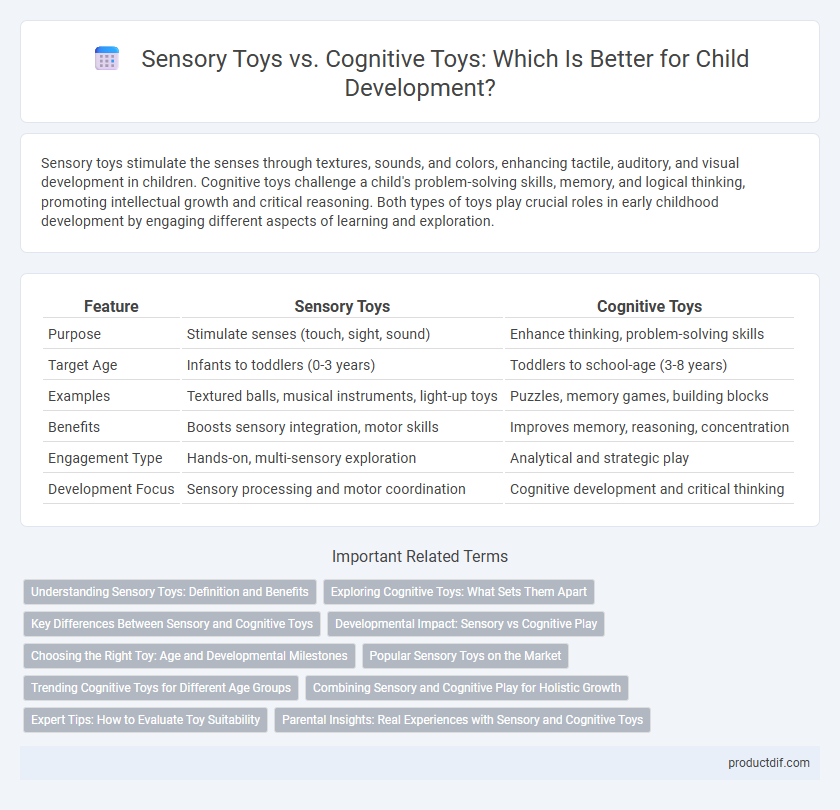Sensory toys stimulate the senses through textures, sounds, and colors, enhancing tactile, auditory, and visual development in children. Cognitive toys challenge a child's problem-solving skills, memory, and logical thinking, promoting intellectual growth and critical reasoning. Both types of toys play crucial roles in early childhood development by engaging different aspects of learning and exploration.
Table of Comparison
| Feature | Sensory Toys | Cognitive Toys |
|---|---|---|
| Purpose | Stimulate senses (touch, sight, sound) | Enhance thinking, problem-solving skills |
| Target Age | Infants to toddlers (0-3 years) | Toddlers to school-age (3-8 years) |
| Examples | Textured balls, musical instruments, light-up toys | Puzzles, memory games, building blocks |
| Benefits | Boosts sensory integration, motor skills | Improves memory, reasoning, concentration |
| Engagement Type | Hands-on, multi-sensory exploration | Analytical and strategic play |
| Development Focus | Sensory processing and motor coordination | Cognitive development and critical thinking |
Understanding Sensory Toys: Definition and Benefits
Sensory toys are designed to engage a child's senses, including touch, sight, sound, taste, and smell, promoting sensory exploration and development. These toys help improve fine motor skills, enhance focus, and support emotional regulation by providing tactile, auditory, or visual stimulation. Understanding the benefits of sensory toys reveals their critical role in aiding children with sensory processing disorders and fostering early brain development.
Exploring Cognitive Toys: What Sets Them Apart
Cognitive toys stimulate problem-solving skills, memory, and logical thinking through puzzles, building blocks, and strategy games, enhancing children's mental development. Unlike sensory toys that primarily engage the senses--touch, sight, sound--cognitive toys challenge understanding, reasoning, and learning processes. These interactive tools foster critical thinking and creativity, making them essential for developing higher-order cognitive abilities in early childhood.
Key Differences Between Sensory and Cognitive Toys
Sensory toys stimulate the five senses, aiding in the development of tactile, auditory, and visual processing skills by providing varied textures, sounds, and colors. Cognitive toys, on the other hand, focus on enhancing problem-solving abilities, memory, and logical thinking through puzzles, pattern recognition, and strategy-based games. Sensory toys support early sensory integration and motor skills, while cognitive toys target brain development and critical thinking skills crucial for academic performance.
Developmental Impact: Sensory vs Cognitive Play
Sensory toys, such as textured balls and musical instruments, stimulate tactile, auditory, and visual senses, enhancing fine motor skills and sensory processing in early childhood development. Cognitive toys like puzzles and memory games promote critical thinking, problem-solving, and memory retention by challenging a child's mental capabilities. Together, sensory and cognitive play contribute to a balanced developmental impact by fostering both sensory integration and intellectual growth.
Choosing the Right Toy: Age and Developmental Milestones
Choosing the right toy depends on the child's age and developmental milestones, as sensory toys are ideal for infants and toddlers who are developing basic motor skills and sensory awareness. Cognitive toys better suit preschoolers and older children, promoting problem-solving, memory, and language skills essential for early learning stages. Matching toys to developmental stages ensures optimal engagement and supports growth in fine motor abilities, sensory processing, and cognitive functions.
Popular Sensory Toys on the Market
Popular sensory toys on the market include tactile balls, textured chew toys, and weighted blankets designed to stimulate touch and proprioception. These toys enhance sensory integration and are often used for children with autism or sensory processing disorders to improve focus and calmness. Brands like Fun and Function, Sensory Goods, and Fat Brain Toys offer a wide range of popular sensory toys that cater to various sensory needs.
Trending Cognitive Toys for Different Age Groups
Trending cognitive toys for different age groups include puzzles, building blocks, and interactive learning tablets that enhance problem-solving and critical thinking skills. For toddlers, shape sorters and memory games promote early cognitive development, while older children benefit from advanced coding robots and STEM kits designed to challenge analytical abilities. These toys are designed to stimulate brain activity, improve concentration, and encourage creativity across various developmental stages.
Combining Sensory and Cognitive Play for Holistic Growth
Combining sensory and cognitive toys enhances holistic development by stimulating multiple brain areas simultaneously, fostering improved motor skills, problem-solving abilities, and emotional regulation. Sensory toys engage tactile, auditory, and visual senses, while cognitive toys challenge memory, attention, and logical reasoning, creating a balanced play experience. Integrating both types in playtime promotes neuroplasticity, supporting comprehensive growth in early childhood learning and development.
Expert Tips: How to Evaluate Toy Suitability
Experts recommend evaluating toy suitability by considering developmental goals, where sensory toys enhance tactile, auditory, and visual stimulation, while cognitive toys promote problem-solving and critical thinking skills. Assess the child's age, interests, and developmental stage to select toys that match their current abilities and encourage growth. Prioritizing safety, durability, and educational value ensures the toy supports meaningful play and learning.
Parental Insights: Real Experiences with Sensory and Cognitive Toys
Parents often observe that sensory toys help toddlers develop motor skills and emotional regulation through tactile, auditory, and visual stimulation. In contrast, cognitive toys challenge older children with problem-solving tasks that enhance memory, reasoning, and attention span. Real experiences highlight that combining both types of toys supports holistic development and keeps children engaged longer.
Sensory toys vs cognitive toys Infographic

 productdif.com
productdif.com